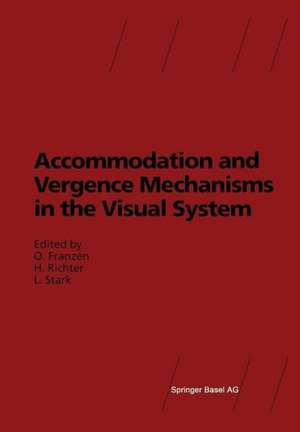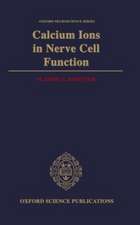Accommodation and Vergence Mechanisms in the Visual System
Editat de Ove Franzen, Hansn Richter, Lawrence Starken Limba Engleză Paperback – 3 oct 2013
| Toate formatele și edițiile | Preț | Express |
|---|---|---|
| Paperback (1) | 923.08 lei 6-8 săpt. | |
| Birkhäuser Basel – 3 oct 2013 | 923.08 lei 6-8 săpt. | |
| Hardback (1) | 926.75 lei 6-8 săpt. | |
| Birkhäuser Basel – 2000 | 926.75 lei 6-8 săpt. |
Preț: 923.08 lei
Preț vechi: 1125.71 lei
-18% Nou
Puncte Express: 1385
Preț estimativ în valută:
176.64€ • 185.79$ • 147.60£
176.64€ • 185.79$ • 147.60£
Carte tipărită la comandă
Livrare economică 08-22 ianuarie 25
Preluare comenzi: 021 569.72.76
Specificații
ISBN-13: 9783034875882
ISBN-10: 3034875886
Pagini: 368
Ilustrații: XIX, 346 p.
Dimensiuni: 170 x 244 x 19 mm
Greutate: 0.59 kg
Ediția:2000
Editura: Birkhäuser Basel
Colecția Birkhäuser
Locul publicării:Basel, Switzerland
ISBN-10: 3034875886
Pagini: 368
Ilustrații: XIX, 346 p.
Dimensiuni: 170 x 244 x 19 mm
Greutate: 0.59 kg
Ediția:2000
Editura: Birkhäuser Basel
Colecția Birkhäuser
Locul publicării:Basel, Switzerland
Public țintă
ResearchCuprins
I CNS pathways, single unit, neural population and structural correlates of the accommodative system.- Neuronal circuits for accommodation and vergence in the primate.- Neural codes for three-dimensional space.- Neuronal connectivity between the accommodative and active fixation systems.- The pupillary light reflex, accommodation and convergence: Comparative considerations.- Vergence eye movement and lens accommodation: Cortical processing and neuronal pathway.- Research on dynamic accommodation using TDO III (Three Dimensional Optometer III) and MEG (Magnetoencephalography).- Neuroanatomical correlates of the near response: Voluntary modulation of accommodation in the human visual system.- Functional neuroanatomy of the human near/far response of the visual system to blur cues: Fixation to point targets at different viewing distances.- Spatial contrast sensitivity and visual accommodation studied with VEP (Visual Evoked Potential), PET (Positron Emission Tomography) and psychophysical techniques.- II Autonomic nervous system, microfluctuations and resting state of accommodation.- Accommodation and the through-focus changes of the retinal image.- Accommodative microfluctuations: A mechanism for steady-state control of accommodation.- Pharmacology of accommodative adaptation.- Behavioral links between the oculomotor and cardiovascular systems.- III Developmental/functional aspects of accommodation.- Development of accommodation and vergence in infancy.- The accommodative response to blur in myopic children.- The role of muscarinic antagonists in the control of eye growth and myopia.- Accommodation, age and presbyopia.- Chromatic stimulus for accommodation to stationary and moving targets.- Error signal detection and dynamics of accommodation.- Mode switching in control of accommodation.- A modified control model for steady-state accommodation.- Binocular accommodation.- IV Health and clinical aspects of accommodation/vergence.- Vertical vergence — normal function and plasticity.- Predicting accommodative performance in difficult conditions: a behavioral analysis of normal variations of accommodation.- The influence of oculomotor function on the optical correction for night myopia.- Effects of neck muscles proprioception on eye position and vergence movements.- Accommodation/vergence/fixation disparity and synergism of head, neck and shoulders.- Changes in accommodation and vergence following 2 hours movie viewing through bi-ocular head-mounted display.- Development of myopia due to environmental problems. A possible interaction of anti-cholinesterase compounds examined by accommodative adaptation.- Epilogue.- Nearwork and visual well-being: A possible contribution of neuroscience.
Caracteristici
LATEST INTERDISCIPLINARY RESEARCH DESCRIBES THE INTERACTION BETWEEN THE VISUAL AND OCULOMOTOR SYSTEMS IN THE BRAIN IS BASED ON THE FIRST INT. SYMPOSIUM ON ACCOMODATION/VERGENCE MECHANISMS IN THE VISUAL SYSTEM, STOCKHOLM,











